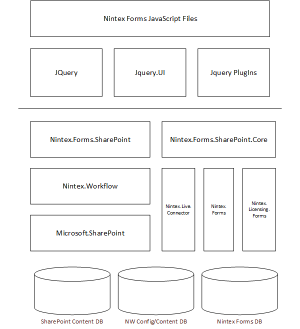Nintex Forms architecture
This topic describes the Nintex Forms architecture.

Nintex Forms JavaScript Files
Nintex Forms are designed in the Forms designer, which is a JavaScript application that produced the form XML that described the designed form. And then a user loads the form XML from a SharePoint list or Nintex Workflow and the form XML and SharePoint context are created with the Forms filler.
The front end package has ASPX pages, JavaScript, and CSS. The architecture is still the same for on premises. A JavaScript handler processes the translations of data. The wrapper has the load, save, publish functions. The canvas does not acre what is in context. It is essentially sites in side of SharePoint and renders the forms.
JQuery
jQuery is a cross-platform JavaScript library designed to simplify the client-side scripting of HTML.
jQuery's syntax makes it easier to navigate a document, select DOM elements, create animations, handle events, and develop Ajax applications. jQuery also provides capabilities for developers to create plug-ins on top of the JavaScript library. This enables developers to create abstractions for low-level interaction and animation, advanced effects and high-level, theme-able widgets. The modular approach to the jQuery library allows the creation of dynamic web pages and Web applications. The set of jQuery core features—DOM element selections, traversal and manipulation—enabled by its selector engine mix algorithms and DOM data structures.
Nintex.Forms.SharePoint
The SharePoint project contains the ASP.NET artifacts, live pages, and user controls. Anything that is SharePoint or Workflow specific lives in this object.
Nintex.Forms.SharePoint produces the WFE WSP, and has the ASPX pages, CSS, JS, and classes that need to reference the workflow and SharePoint.DLLs.
Nintex.Forms.SharePoint.Core
This is the application Server WSP which deploys the Nintex DLLs and artifacts required across all of the servers in the farm. The DLLs include the Nintex.Forms.SharePoint. The core has all of the DLLs rather then the front end assets.
Nintex.Workflow
The workflow application creates SharePoint declarative workflows that run in the SharePoint workflow engine. In Nintex Workflow 2013, Nintex workflows encapsulate SharePoint 2013 workflows to provide additional metadata and Nintex-specific functionality, such as versioning, interactive development, and reporting.
Workflows contain:
- Microsoft SharePoint Activities
Activities are the combined to create a SharePoint 2013 Workflow. Activities are the units of work that are composed to produce workflow based functionality.
- Microsoft .NET Activities
In the .NET Framework a hierarchy of classes with the base class, Activity Class, an abstract class that is used to create composite activities. Activities explicitly declare their inputs and outputs via arguments. The Standard Activity Library are introduced a number of low level activities. These low level activities include Assign, Add to Collection, Remove for Collection, Clear for Collection, and Invoked Method.
- .Nintex Actions
In Nintex Workflow 2013, workflow actions are the fundamental building blocks of Nintex workflows. Workflow actions encapsulate SharePoint workflow activities, adding Nintex-specific functionality such as reporting and the Run Now feature.
Microsoft.SharePoint
SharePoint combines various functions which are traditionally separate applications: web server, content management, document management, personal network file sharing, enterprise social networking, enterprise search, business intelligence, workflow management, web content management, and an enterprise application store. SharePoint 2013 uses the Microsoft stack. Specifically, this includes the following elements:
- Microsoft Windows Server
- SQL Server
- Internet Information Services (IIS)
- Windows Workflow Foundation
- .Net Framework
Databases
- SharePoint Content DB
The content database handles the tracking of workflow instances. As a workflow runs, it adds records to the tables in the content database, and this data is used for the generation of reports and the management of business rules for user tasks.
- NW Config DB
The configuration database has a table that maps site collections to content databases. All workflow tracking data for a particular site collection is stored within the one content database. A content database can contain the data for multiple site collections.
- Nintex.Forms DB.
The Forms Database contains Nintex live information. It contains the pointers to the a mobile layout and to live.